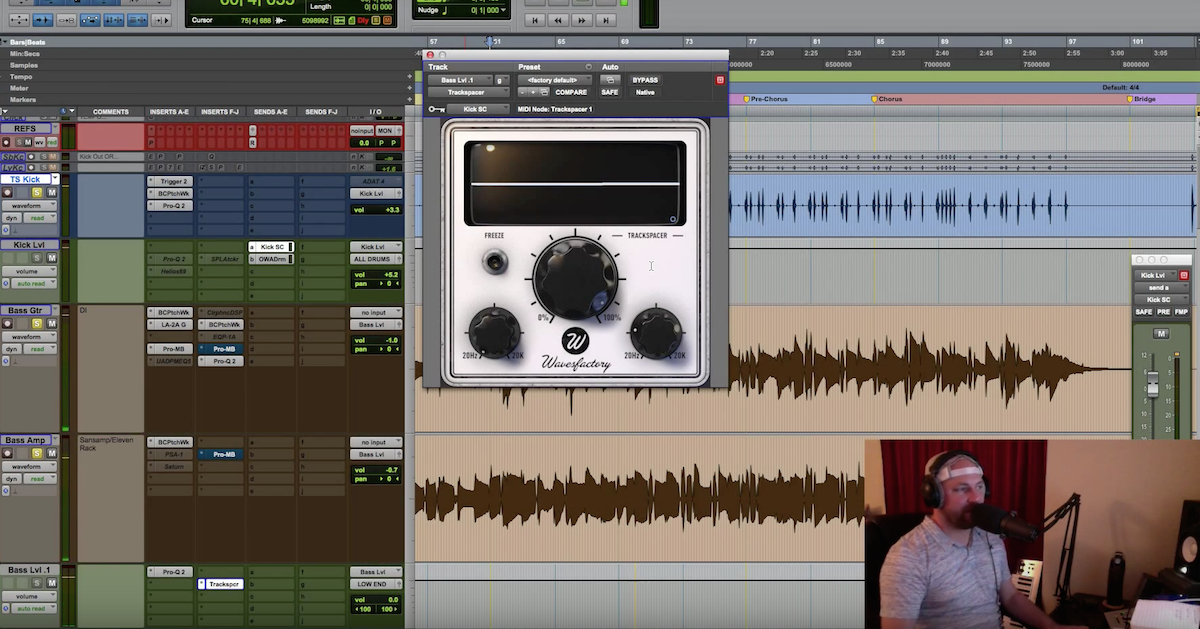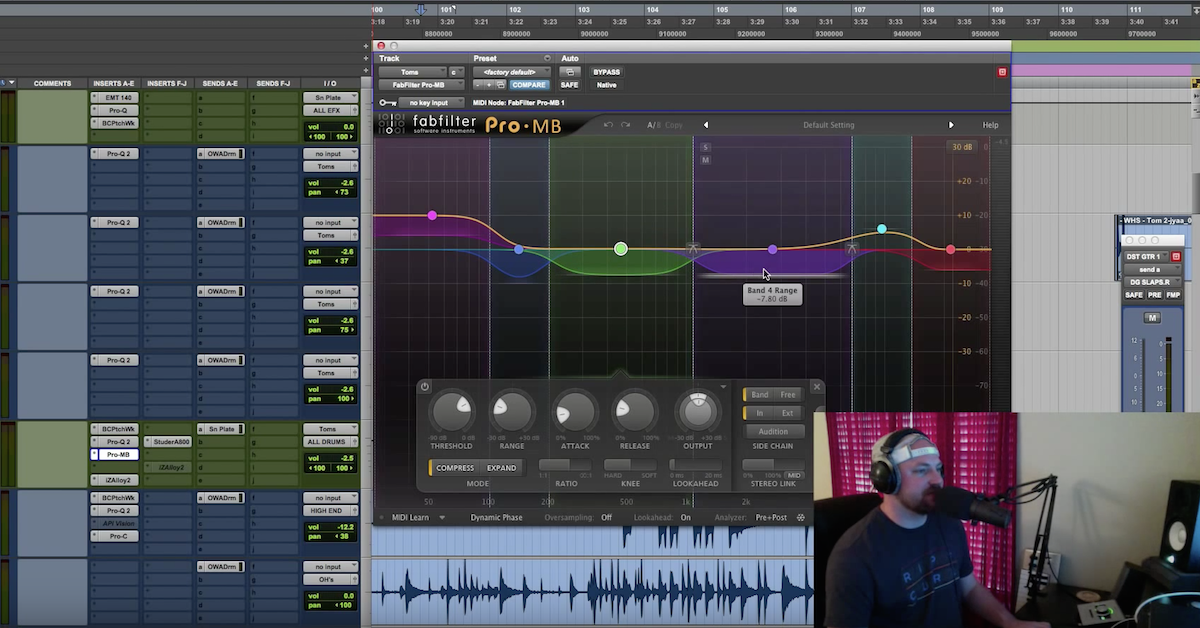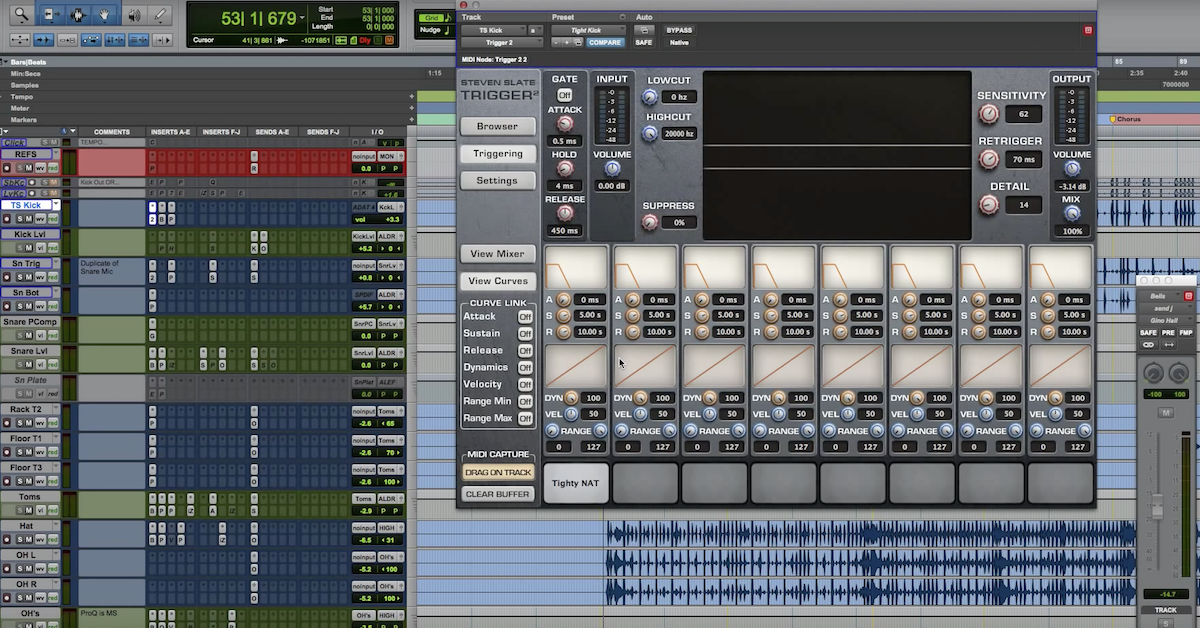How to Mix Bass and Kick with Multiband Sidechain Compression
Today we’re talking about sidechain compression with the kick and bass. I know this has been covered quite a bit. I’ve specifically got a pop/hip-hop track here. The EDM thing has been beat to death, I think there’s all kinds of tools out there. You actually don’t even need to sidechain into a compressor anymore. They’ve got Nicky Romero KICK and Kickstart. You can pick the pumping rate for a four on the floor beat.
Today I’ll show you how I sidechain kick and bass with parallel processing in the mix.
[music]
Let’s take a look at what the kick and bass are doing. We’ve got my kick that I’ve pulled in and generated from a virtual instrument. You guys may have seen that in my other stuff. KICK from Sonic Academy and Nicky Romero. And the kick is going out a bus I’ve labeled kick sc. For kick sidechain. That’s gonna go to the end of my bass chain, you’ll see here I’ve got bass level. With Waves RBass, some EQ, and then multi-band. The FabFilter Pro-MB, a beautiful plugin. I’ve got that coming in that buss, kick sc is coming in the external chain of the FabFilter Pro-MB. And then within the bands you have the option to select whether you want that to be triggered by an internal or an external sidechain. In this case I want external. I want the kick to trigger compression. You’ve got your bass guitar, and if you want the kick to dominate, by sending the kick into the compression, you can smack down the level of a frequency range that you set and set how much you want it to drop.
The kick is going to hit and instantly this sidechain compression is going to drop those frequencies between 20 and 132 Hz. They’re all going to just smack down based on the threshold and range I set. I’ve got a -8 range. Which is a bit steep for what I’m used to doing, I guess I used my ears in this case. So when that kick hits, it’s gonna dominate in that frequency range. You can see in this I’ve also got a midrange sidechain set up. I hear a lot of the attack of the kick competing with the fuzziness and the distortion that I put on the bass amp tone. So, I was messing around trying to see what it would sound like if I side-chained all the mid and the upper of the bass so that that section, that frequency range dipped as well. Maybe something to consider is how the kick mids and the highs are reacting to the bass mids and highs.
Let me come back down here, I use Ozone at the end of my 2-buss chain and I’ve got the IRC set to 3 which has an incredible amount of latency. Here we go from, say, right when the bass was in. Let’s pull open the Pro-MB and focus on just this sub region.
[kick and bass with FabFilter-Pro MB multiband sidechain compression]
Now I’m gonna bypass it and I want you to listen to how it feels stale. When I bypass it I feel like everything is just a mess. The kick is doing it’s thing and there’s just no real like connection between the kick and the bass. So, let’s bypass it and then while it’s playing I’ll re-engage it and we’ll hear the difference.
[kick and bass without FabFilter-Pro MB multiband sidechain compressor]
I don’t like saying the word glue too much, but if you’ve heard that, you kind of know what’s going on there. You can hear them gel together I guess a couple of things to be thinking about when you’re using sidechain compression is your attack time and release time.
I like to let them be fast. I like the attack to hit immediately so it gets it’s out of the way and I like the release to be quick so as soon as the sub — let me first say this: I like, most of the time you’ll find that my kicks are short in the decay/sustain/release department. They’re gonna be tight. They’re gonna be punchy. Get in, get out. They’re gonna get out of the way so the bass can resonate and fill sub frequency space.
If you have any questions feel to hit me up, david[at]davidglennrecording.com. I’ll be sure to elaborate or find a better way to explain it. But that’s kind of how I’m working with kick and bass on rock/pop/hip-hop. I would do this in dance b there’s another plugin, it’s a VST and I gotta pull it in through the Bluecat’s Patchwork. Here’s Kickstart. I’ve shown you KICK, this is Kickstart. And it’s by Nicky Romero, not by Sonic Academy on this one. You can pull back your mix percentage from 0 to 100. You can pick different types of sidechain effects you want. And per instrument, you can give it it’s own character to how it relates to a four on the floor kick. Then you can set it to be obviously 8th, half, whole note sidechain. That’s the Nicky Romero Kickstart. And that’s gonna be more applicable towards EDM dance music where you have a four on the floor.
Hopefully you guys are picking that up. Hit me up via email if you have questions on the kick sidechain, attack, release, threshold — if you want me to elaborate feel free to hit me up and we’ll talk then.





